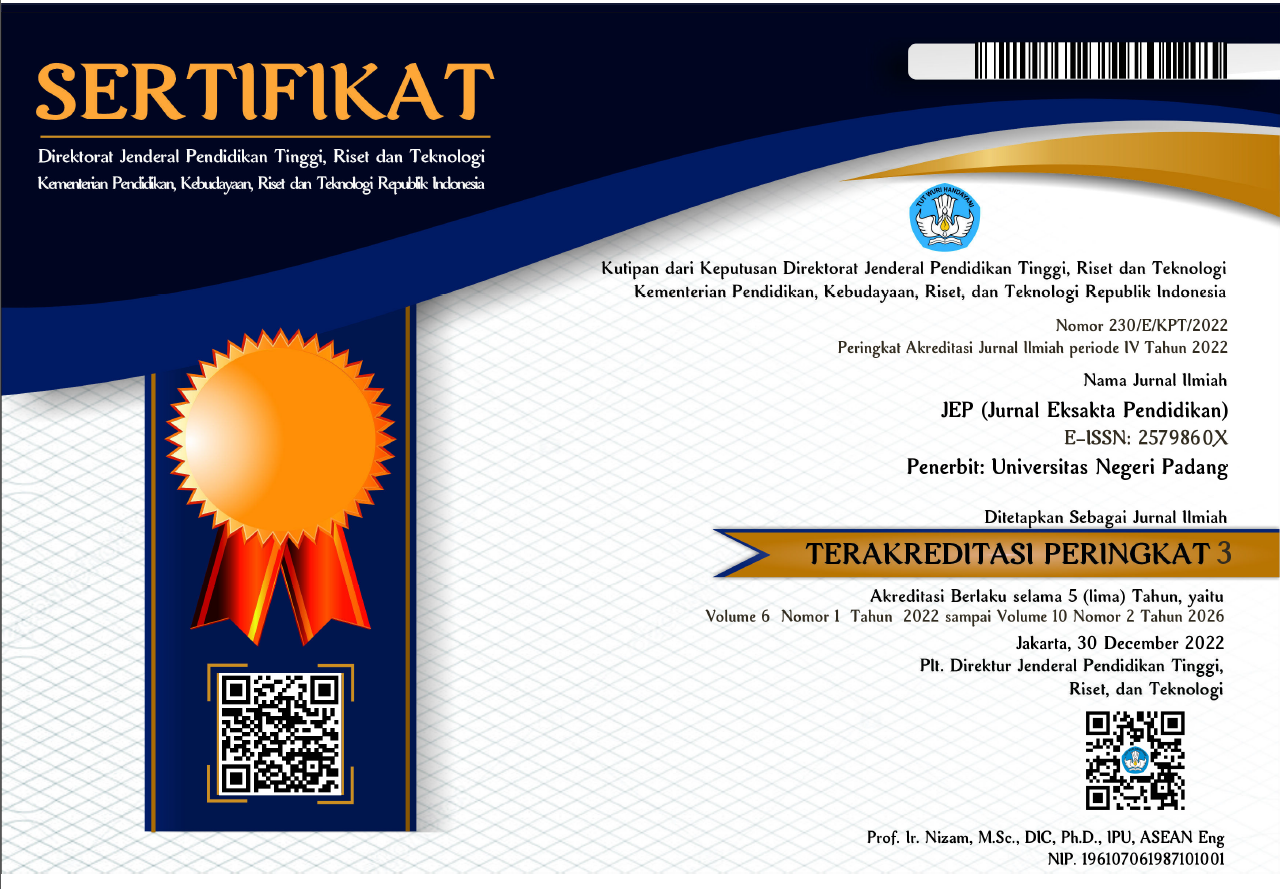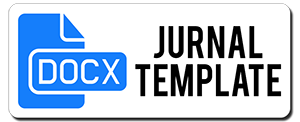Perkembangan Model Mental Mahasiswa pada Penggunaan Bahan Ajar Kesetimbangan Kimia berbasis Inkuiri Terbimbing
Abstract
This research aimed to analyze students' mental models in chemical equilibrium before and after using guided inquiry-based learning material. The instrument used was a conceptual test which has been developed by Bergquist and Heikkinen. This test was taken before and after formal instruction using the learning material. Responses were obtained from 30 first-year students of Faculty of Mathematics and Natural Science of UNP which taking general chemistry course in 2017/2018 even semester using purposive sampling. Student answers to this test were analyzed descriptively. From this research, student understanding increase after using the learning material. The highest increasing is in equilibrium shifting stoichiometry concept. This gaining correlated to students’ mental model development. The results of this study indicated that in general there has been a development of students’' mental models before and after using this learning material. Although, not all students’ model mental are appropriate to scientific concepts in chemical equilibrium.
Downloads
References
Barke, H.-D., Hazari, A., & Yitbarek, S. (2009). Misconceptions in Chemistry. Berlin: Springer. https://doi.org/10.1007/978-3-540-70989-3
Bergquist, W., & Heikkinen, H. (1990). Student ideas regarding chemical equilibrium: What written test answers do not reveal. Journal of Chemical Education, 67(12), 1000–1003. https://doi.org/10.1021/ed067p1000
Chiu, M.-H., Chou, C.-C., & Liu, C.-J. (2002). Dynamic processes of conceptual change: Analysis of constructing mental models of chemical equilibrium. Journal of Research in Science Teaching, 39(8), 688–712. https://doi.org/10.1002/tea.10041
Coll, R. K., & Taylor, N. (2002). Mental Models In Chemistry: Senior Chemistry Students’ Mental Models Of Chemical Bonding. CHEMISTRY EDUCATION: RESEARCH AND PRACTICE IN EUROPE, 3(2), 175–184.
Cullen, D. M., & Pentecost, T. C. (2011). A model approach to the electrochemical cell: An inquiry activity. Journal of Chemical Education, 88(11), 1562–1564. https://doi.org/10.1021/ed101146u
Hanson, D. M. (2013). Instructor’ s Guide to Process Oriented Guided Inquiry Learning. Hampton, New York: Pacific Crest.
Hunnicutt, S. S., Grushow, A., & Whitnell, R. (2015). Guided-Inquiry Experiments for Physical Chemistry: The POGIL-PCL Model. Journal of Chemical Education, 92(2), 262–268. https://doi.org/10.1021/ed5003916
Ibrahim, B., & Rebello, N. S. (2013). Role of mental representations in problem solving : Students ’ approaches to nondirected tasks, 020106(July), 1–17. https://doi.org/10.1103/PhysRevSTPER.9.020106
Johnstone, A. H. (1993). The Development of Chemistry Teaching A Changing Response to Changing Demand. Journal of Chemical Education, 70(9), 701–705.
Karpudewan, M., Treagust, D. F., Mocerino, M., Won, M., & Chandrasegaran, A. L. (2015). Investigating High School Students ’ Understanding of Chemical Equilibrium Concepts. International Journal of Environmental & Science Education, 10(6), 845–863. https://doi.org/10.12973/ijese.2015.280a
Kousathana, M., & Tsaparlis, G. (2002). Students ’ Errors In Solvig Numerical Chemical-Equilibrium Problems. Chemistry Education Research and Practice In Europe, 3(1), 5–17. Retrieved from http://dx.doi.org/10.1039/B0RP90030C
Kuhlthau, C. C., Maniotes, L. K., & Caspari, A. K. (2007). Guided Inquiry Learning in 21st Century. USA: Libraries Unlimited.
Ollino, M., Aldoney, J., Domınguez, A. M., & Merino, C. (2018). Research and Practice A Coll anew multimedia application for teaching and learning chemical equilibrium. Chemistry Education Research and Practice, 19, 364–374. https://doi.org/10.1039/C7RP00113D
Özmen, H. (2007). The Effectiveness of Conceptual Change Texts in Remediating High School Students ’ Alternative Conceptions Concerning Chemical Equilibrium. Asia Pacific Education Review, 8(3), 413–425. Retrieved from http://doi.wiley.com/10.1002/tea.10041
Pedrosa, M. A., & Dias, M. H. (2000). Chemistry Textbook Approaches To Chemical Equilibrium And Student Alternative Conceptions. Chemistry Education Research and Practice In Europe, 1(2), 227–236.
Supasorn, S., & Promarak, V. (2015). Implementation of 5E inquiry incorporated with analogy learning approach to enhance conceptual understanding of chemical reaction rate for grade 11 students. Chemistry Education Research and Practice, 16, 121–132. https://doi.org/10.1039/C4RP00190G
The College Board. (2012). AP® Chemistry Guided-Inquiry Experiments: Applying the Science Practices (Teacher Manual). New York: The College Board.
The College Board. (2013). AP ® Chemistry Guided Inquiry Activities for the Classroom. New York: The College Board.
Tumay, H. (2014). Prospective chemistry teachers’ mental models of vapor pressure. Chemistry Education Research and Practice, 15, 366–379. https://doi.org/ 10.1039/c4rp00024b

This work is licensed under a Creative Commons Attribution 4.0 International License.




_(2579-860X).png)
_(2614-1221)1.png)




